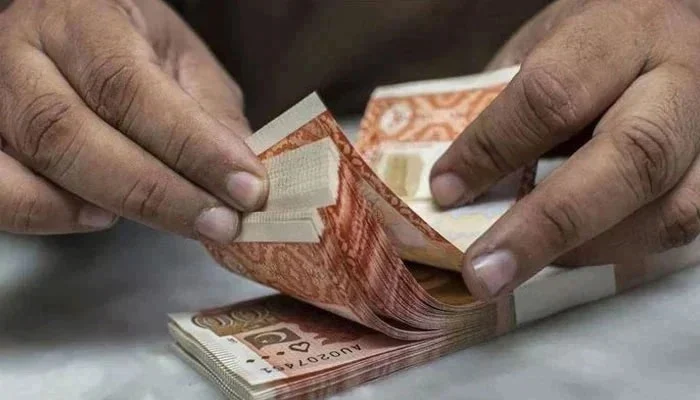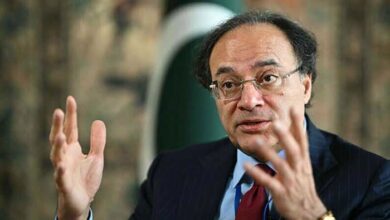ISLAMABAD: Pakistan’s public debt has soared to a staggering Rs76.01 trillion ($269 billion) as of March 2025, marking a near four-and-a-half-fold increase since 2015 and highlighting persistent fiscal imbalances and years of political mismanagement.
According to the Pakistan Economic Survey 2024–25, the country’s debt now stands at 66.27% of GDP — exceeding the statutory ceiling prescribed by the Fiscal Responsibility and Debt Limitation Act (FRDLA).
From General Pervez Musharraf’s military regime to the present administration, successive governments have relied heavily on borrowing to finance expenditures. Over the past decade, public debt has risen by 337%, and since 2008, it has grown by an alarming 994%.
The burden on citizens has grown correspondingly, with each Pakistani —newborns included — now effectively saddled with Rs277,462 in debt.
The sobering figures, released on Monday as part of the Pakistan Economic Survey 2024-25, underscore an entrenched reliance on debt rather than a path toward fiscal sustainability.
Pakistan’s total population is currently estimated at 241.5 million, while its GDP at market prices stands at Rs114.69 trillion ($411 billion).
In 2001, Pakistan’s total public debt stood at just Rs3.68 trillion. By the time Musharraf exited in 2008, it had climbed to Rs6.13 trillion.
The PPP government under President Zardari more than doubled it to Rs14.29 trillion by 2013. Under Nawaz Sharif’s PML-N (2013–2018), debt ballooned again to Rs24.95 trillion — adding over Rs10 trillion more. During its 44-month rule (Aug 2018–Mar 2022), Imran Khan’s PTI government added over Rs19.4 trillion to public debt, pushing the total to Rs44.37 trillion.
Including post-ouster spillovers, the figure exceeds Rs22 trillion —marking one of the fastest debt accumulations in Pakistan’s history. Despite rhetoric of austerity, PTI’s tenure saw heavy domestic borrowing, currency depreciation, and increased refinancing risks, amplifying fiscal stress.
But another rapid accumulation came since April 2022, the government has added a jaw-dropping Rs31.64 trillion in just three years.
As of March 2025, domestic debt stood at Rs51.52 trillion while external debt hit Rs24.49 trillion ($87.4 billion). Servicing this colossal burden is draining government finances.
In the first nine months of FY2025, interest payments totaled Rs6.44 trillion — 66% of the Rs9.78 trillion budgeted for the year. Of that, Rs5.78 trillion went to domestic debt, and Rs656 billion to external.
The Ministry of Finance claims improved cash-flow planning and longer-term debt instruments have helped manage in a relative short-term risks, but the underlying trajectory remains deeply concerning.
During July-March FY2025, Pakistan received $5.07 billion in gross external disbursements — $2.8 billion from multilaterals, $2.01 billion from commercial/other lenders, and $258 million from bilateral partners.
No global bonds were issued during this period, signaling limited access to capital markets. Whereas, outflows repayments totaled $5.636 billion, with multilateral creditors receiving the largest portion ($2.828 billion), followed by bilateral creditors ($1.565 billion), and commercial/other sources ($1.243 billion).
Meanwhile, Pakistan witnessed a growth of 6.7% in public debt during the first nine months of FY2025 to Rs76.007 trillion with domestic debt of Rs51.518 trillion and external debt at Rs24.489 trillion. The government, however, spent Rs6.439 trillion in the head of debt servicing during July-March period, says the Economic Survey 2024-25.
“This was lower as compared to the growth of 7.4% in the same period of the preceding year, mainly due to increased primary surplus. The main factors behind the increase in total public debt stock during the first nine months of the ongoing fiscal year.”
During the first nine months of the outgoing fiscal year, total markup expenditure amounted to Rs6,439 billion, representing 66% of the full-year budget estimate of Rs9,775 billion.
The majority of this expenditure was on domestic debt, which accounted for Rs5,783 billion or 66% of the annual allocation of Rs8,736 billion, whereas interest payments on external debt reached Rs656 billion, equivalent to 63% of the budgeted Rs1,039 billion.
Within the domestic debt portfolio, the government primarily relied on long-term instruments such as Pakistan Investment Bonds (PIBs) and Sukuk (Islamic Bonds) to finance the fiscal deficit and meet debt repayment obligations.
This strategic shift enabled the retirement of Treasury Bills (T-bills) amounting to Rs2.4 trillion, reducing the volume of short-term securities and improving the debt maturity profile







